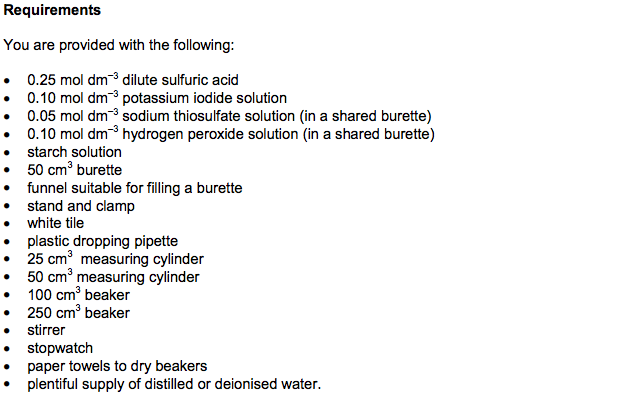



A-level Chemistry exemplar for required practical No. 7 – part a Measuring the rate of reaction by an initial rate method: An ‘Iodine Clock’ experiment: To investigate the reaction of iodide(V) ions with hydrogen peroxide in acidic solution and to determine the order of the reaction with respect to iodide ions. Student sheet The ‘Iodine Clock’ experiment can be used to determine the effect of a change in concentration of iodide ions on the reaction between hydrogen peroxide and iodide ions. Introduction Hydrogen peroxide reacts with iodide ions to form iodine and the thiosulfate ion immediately reacts with iodine as shown below. H2O2(aq) + 2H+(aq) + 2I– (aq) → I2(aq) + 2H2O(l) 2S2O3 2– (aq) + I2(aq) → 2I– (aq) + S4O6 2– (aq) When the I2 produced has reacted with all of the limited amount of thiosulfate ions present, excess I2 remains in solution. Reaction with the starch then forms a dark blue-black colour. By varying the concentration of I – , you can determine the order of reaction with respect to I – ions. Requirements You are provided with the following: 0.25 mol dm–3 dilute sulfuric acid 0.10 mol dm–3 potassium iodide solution 0.05 mol dm–3 sodium thiosulfate solution (in a shared burette) 0.10 mol dm–3 hydrogen peroxide solution (in a shared burette) starch solution 50 cm3 burette funnel suitable for filling a burette stand and clamp white tile plastic dropping pipette 25 cm3 measuring cylinder 50 cm 3 measuring cylinder 100 cm3 beaker 250 cm3 beaker stirrer stopwatch paper towels to dry beakers plentiful supply of distilled or deionised water. Suggested method Experiment 1 a) Rinse a 50 cm3 burette with potassium iodide solution. Fill the burette with potassium iodide solution. b) Transfer 10.0 cm3 of hydrogen peroxide solution from the shared burette provided to a clean, dry 100 cm3 beaker. You will use this in step (h). c) Use a 50 cm3 measuring cylinder to add 25 cm3 of sulfuric acid to a clean, dry 250 cm3 beaker. d) Use a 25 cm3 measuring cylinder to add 20 cm3 of distilled or deionised water into the 250 cm3 beaker. e) Use a plastic dropping pipette to add about 1 cm3 of starch solution to this beaker. f) Use your burette to add 5.0 cm3 of potassium iodide solution to the mixture in the 250 cm3 beaker. g) Finally, add 5.0 cm3 of sodium thiosulfate solution from the shared burette provided to the mixture in the 250 cm3 beaker. Make sure this sodium thiosulfate solution is added last. h) Stir the mixture in the 250 cm3 beaker. Pour the hydrogen peroxide solution from the 100 cm3 beaker into the 250 cm3 beaker and immediately start the timer. Stir the mixture. i) Stop the timer when the mixture in the 250 cm3 beaker turns blue-black. Record the time to an appropriate precision in a table of your own design. This experiment could take several minutes. j) Rinse the 250 cm3 beaker with distilled or deionised water and dry it with a paper towel. Experiments 2–5 k) Repeat steps (b) to (j) in four further experiments using the volumes shown in the following table. Volumes of solutions added to 250 cm3 beaker Volume in 100 cm3 beaker Experiment Sulfuric acid 0.25 M / cm3 Starch / cm3 Water / cm3 Potassium iodide 0.10 M / cm3 Sodium thiosulfate 0.05 M / cm 3 Hydrogen peroxide 0.10 M / cm3
/
~
~
~
/
3.1.9.2 Determination of rate equation (A-level only)
Required practical 7
Measuring the rate of reaction:
• by an initial rate method


 1.9 Rate Equations Page 3
1.9 Rate Equations Page 3 Practical Guide Page : 130 - 131
Practical Guide Page : 130 - 131 Oxford Textbook Pages : 286, 518
Oxford Textbook Pages : 286, 518 CGP Revision Guide Pages : 67
CGP Revision Guide Pages : 67